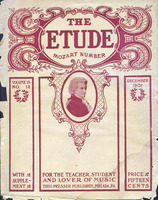The principles given in the last article on Interpretation-Analysis hold as well for opera as for song. In opera there are the added advantages of various supplementary aids to expressing the combined idea of poet and composer. Skilful managing of the lighting apparatus, the scenic surroundings, gesture, action, are all important factors in presenting a picture or inducing a certain state of emotion. But because of this great assistance the singer must not give any less thought to the careful preparation from the interpretative stand-point to the words and music of his or her part. Color, attack, pause, movement are each to be brought into service to make the part allotted as clear and finished as would be requisite in a concert-room. Here the coldness and barrenness of the surroundings, in which every defect, be it never so slight, stands out prominently, require all the singer’s resources to give, against such sharp relief, a perfect rendering.
I realize that the infinite care and thought bestowed on a song when increased to meet the requirements of an operatic rôle means great toil and expenditure of time. But it has its own reward. The truly great opera-singers of to-day are great because of just this great amount of time devoted to their work. They bring it to bear on Mozart as well as Wagner, and the perfect finesse of the former helps the larger more sustained lines of the latter.
In the song from Mozart’s “Marriage of Figaro,” “Voi, Che Sapete,” we have not the broad modern sweep of emotion, but something naïve and child-like, in which the innocence and unworldliness of childhood play around the charming melody as sunlight plays about a lovely flower.
The song opens with a quiet, graceful melody giving an atmosphere for the initial emotional plane. The voice enters with a pleading appeal, the result of a confused mental condition on the part of the character singing. A pleading stress on the first note followed by a slight increase in intensity to the beginning of the twelfth bar, with greater stress on the first note of measure thirteen, with a corresponding increase in intensity to the end of the phrase, giving the phrase “s’io l’honel cor?” with a restrained, quiet intensity, infusing into the voice a certain innocent wonder. Bring in the pleading accents again on the “donne, vedete” to the end of the phrase. Holding back—that is, suspending the consonants on the accented syllables—will help in this. Here division 1 of the song ends.
The singer now becomes more confiding and reflective. The tone of the voice must express this just as it would in speaking, and continual practice of the color-effect desired, in the speaking voice, will make it simpler to incorporate it into the singing voice. From “quello, ch’io provo” through “capir not so” is to be given in the foregoing manner. Beginning the phrase “sento un affetto” the voice should be more intense, increasing slowly and steadily until the phrase “ge lo e poi,” when the voice should assume a suppressed confusion and unrest until the phrase “torno gelar” when it should express despair, which is the result of the lack of understanding. The same nervous unrest continues in the voice down through the phrase “voi, che sapete,” when with renewed pleading the voice takes up the first words and melody, infusing into the color of the voice a certain effect of helplessness.—Robert Bruce Pegram.



